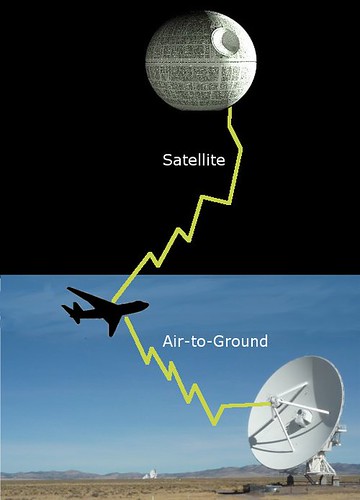Big news from the Blue Crew earlier this week when JetBlue announced it would finally be installing broadband internet onboard. But this isn’t just any internet, it’s Ka (“kay-ay”) band. What the heck is that and why should you care? Let me explain.
First, let’s start with the basics. There are two kinds of basic internet connections that you can use on an airplane. Air-to-ground and satellite. This should be pretty self-explanatory, but just in case . . .
Pretty easy, right? Air-to-ground is the most popular in the US right now thanks to Aircell’s aggresive push with GoGo. It’s cheap to install, but it’s harder to grow bandwidth without adding new towers on the ground. And the biggest constraint is that it only works where there is ground below. Sorry ocean-bound flights.
Satellite-based internet started off quickly out of the gate, but it stalled for awhile. Remember Connexion by Boeing? That was on planes years ago, and it was expensive. After the system folded, there was a big lull until recently.
Now satellite-based internet is back again. Row 44 is leading the charge in the US, and Southwest is putting it on a couple planes a week as we speak. Others, like Panasonic, are moving in quickly as well. It’s a more expensive and longer initial install process, but then it has the ability to work anywhere in the world as long as enough satellites are up and running. The system out there today uses the Ku (“Kay-you”) band.
Ka band is supposed to be the next big thing. For it to matter, it needs to do two things:
- Be cheaper
- Have more bandwidth
And that’s exactly the plan, but it’s not there yet. When I roamed the halls at the Airline Passenger Experience Association expo last week, the general consensus was that we were at least 5 years away from having a meaningful Ka band solution for airlines. There just aren’t enough satellites yet and certification takes a long time.
So how and why is JetBlue doing this? Let’s start with the “why” here. Take a look at this map showing routes from New York (couldn’t get a full route map, but this gives you a good idea).
As you can see, air-to-ground misses a huge chunk of the JetBlue network. The increasing growth into the Caribbean is a dark spot, not to mention all those Northeast flights to Florida that fly off the coast, out of range. So satellite makes a lot of sense.
But why not go with Ku band today instead of waiting until mid-2012 for the first install? It’s probably something JetBlue learned from its ill-fated BetaBlue experiment with onboard wifi. If you recall, BetaBlue was early out of the gate and used narrowband that only allowed you to check email and a couple of pre-determined websites. Nobody cared. So JetBlue wants to leapfrog to a more robust bandwidth system than what’s out there today. Oh, and it’ll be cheaper.
Besides, with its partnership with ViaSat, it will handle everything through its LiveTV subsidiary. Every time I’ve spoken with LiveTV in the past, the math hasn’t worked for them to get into the wifi world. It was just too expensive and usage wasn’t enough. Now that’s apparently changed.
I have to think that with this cheaper Ka band solution, it now makes sense for LiveTV. LiveTV can also offer this to other existing partners, like Continental which hasn’t started its GoGo trial yet. United only has GoGo on the handful of planes that fly from JFK to LA and San Francisco, so this could be a great opportunity.
The long leadtime might be bothersome, but it’s a calculated effort. Think about it for a second. Usage of wifi is very low right now, that we know for sure. But the expectation is that it will eventually be used much more. Two years isn’t that long to wait, I suppose, for something that isn’t seeing much use today.
But will it actually be two years? The certification process is long and arduous. If the plan is only to have coverage over the Continental US by then (listen to IAGBlog’s excellent interview with SVP Marketing/Commerical Marty St George on this), then that’s an easier task, but the satellites haven’t even been launched yet. I would assume this date is tentative.
And then, when will full coverage over the airline’s network be available? And will the performance and cost really come in as advertised? Hard to say at this point, though they apparently feel confident enough to make the announcement.
So, if everything works as planned, I like this. Nice work. Now, when are we going to see powerports?


